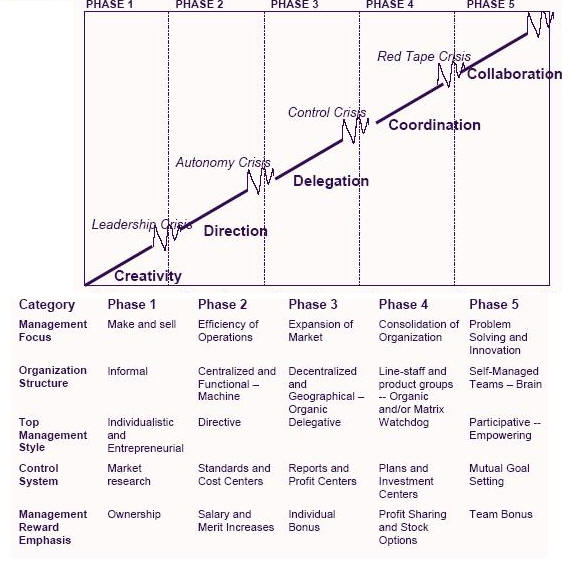
Organizational and Individual Change
Organizational and Individual Change
Definition of change
Greiner’s Model
of Organizational Change and Development
Greiner
argues that growing organizations move through five distinguishable phases of development,
each of which contains a calm period of growth that ends with a management crisis.
He sees each phase as both an effect of the previous phase and a cause on the next
phase. A management team with its own sense of history can anticipate and prepare
for the next developmental crisis. He prescribes appropriate action in each of the
five phases so that the organizational crises become growth opportunities. The
evolutionary phases are the calm stages of growth without major upheaval. The
revolutions are those periods of substantial turmoil in organizational life. Any
organization that is growing rapidly due to changes in technology, markets, global
opportunities, or just a wonderful economy, is likely to experiences evolutionary and
revolutionary growth pangs during the inevitable changes associated with this growth.

From Creativity to
Direction
The
first evolutionary phase is called creativity. During the creativity phase the
organization is born and creating its products and markets. The organization is
small compared to what it will be, and young. This creativity period is
characterized by managers-founders who are managerial, technically oriented, disdain
management activities, prefer frequent but informal communication, and react quickly to
beneficiaries’ reactions to the product. Organizational energy is focused on making
and selling the product-service. People in this phase of the organization are all
expected to work long hours and be rewarded with modest salaries with the promise of
future ownership benefits.
The
creativity phase ends with the crisis of leadership. As the organization grows the
individualistic managerial technical leaders of the creativity phase need to change
or be replaced with more efficiency-minded managers willing to establish formal
communications, control, product manufacturing, and performance management systems.
The people who join the organization at this time may not be as motivated by intense
dedication to the product, the organization, the founders, or the survival of the
organization. The key task during this crisis is to find a strong project/programme purpose oriented
manager who is also acceptable to the founders and the original organizational members.
The
second evolutionary phase is called direction. In the direction phase a functional
organizational structure is established with increasing specialization for tasks,
numerical control systems are installed, work becomes standardized, budgets are set up,
communication is characterized by information flowing up and centralized decisions
cascading down the hierarchy. The focus of the organization in the direction phase
is operational efficiency. The reward emphasis is no longer the promise of
ownership, as in the creativity phase, but rather salary and merit increases associated
with performance according to system metrics.
The
direction phase ends with an autonomy crisis. As the organization becomes more
complex and diverse, lower level members of the organization feel restricted by the
bureaucratic systems. Managers need to delegate and empower more but this is often
challenging for directive style managers to do. Many organizations start to stagnate
at this stage, if their managers cannot figure out how to shift to a more participatory
and flexible style.
Delegation,
Coordination and Collaboration
The
delegation stage follows the autonomy crisis. In the delegation phase there is a
more decentralized organizational structure, more empowerment at all levels in the
organization, a shift from cost centers to profit centers, and bonuses tied to profit
performance are used as rewards. The focus of organizational attention in this
phase is growing the market and market share. Often there is a shift from an
internal to a beneficiary focus. The crisis of control occurs to end this phase as
managers feel they are losing control of an increasingly diverse field and then seek to
regain control. The organization is larger and more complex, and if they
successfully navigate this crisis, they move into the coordination phase.
In
the coordination phase the focus of organizational attention is consolidation of the
organization – again a shift back to the internal focus. The coordination phase
is characterized by the merger of departments into more coherent groups, mergers and
acquisitions with other entities to make sense of market and financial positions, the sale
of divisions that do not make sense, review and centralization of all the information and
financial systems. Daily operational and staff performance review systems stay
decentralized. Each entity becomes an investment center – a miniature operating
unit. Stock options and profit sharing are used to encourage identity with the organization.
Field-unit managers become adept at the use of the key organizational buzz
words. Eventually the coordination phase bogs down in the crisis of red tape.
Essentially, the red tape crisis is a conflict between the headquarters and the individual
units – often the local vs. global organizational issues are at the heart of this
crisis.
In
the fifth phase of growth, collaboration, there is more use of cross-organization teams,
more skillful use of local and global perspectives, increased ability to confront and
resolve differences about organizational direction and more use of interdisciplinary
learning. Greiner did not develop a crisis for the last phase.
Like
Tuckman’s team development model, organizations may not successfully develop through
every phase. Some organizations fold during the crisis of leadership at the end of
the creativity phase. Others fail to survive the crises that end subsequent
evolutionary phases. So this model is developmental but not inevitable.